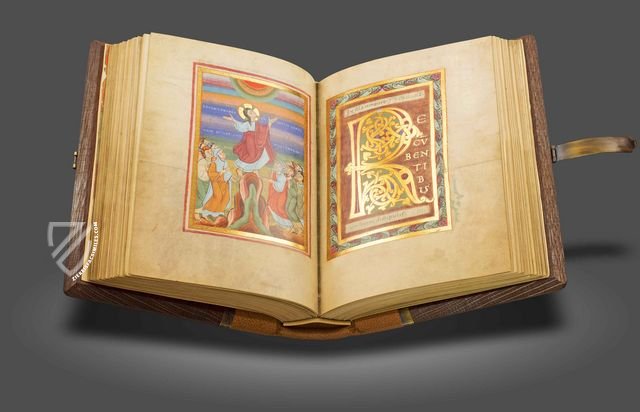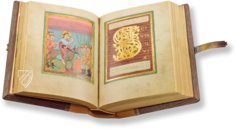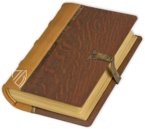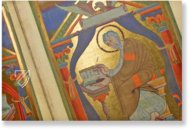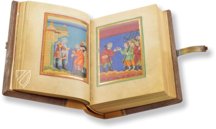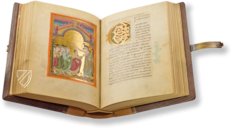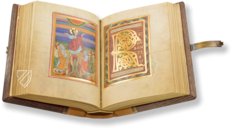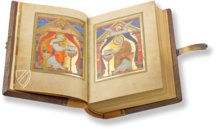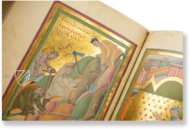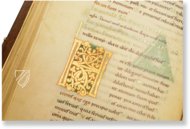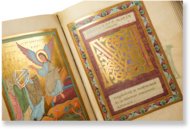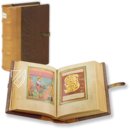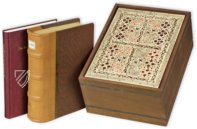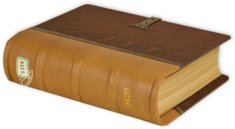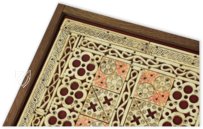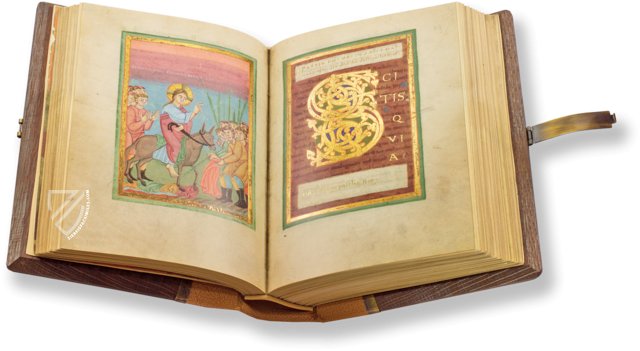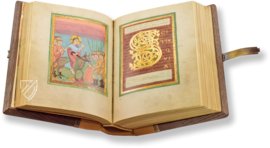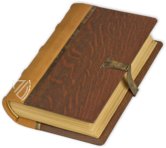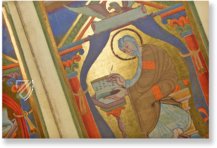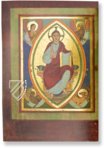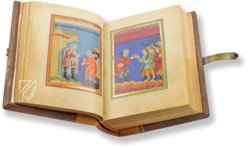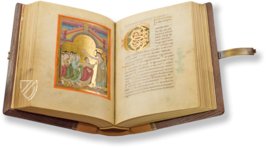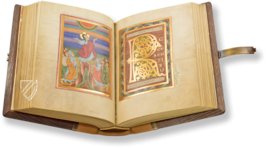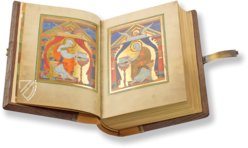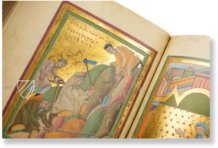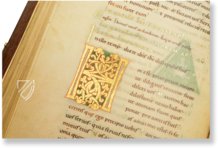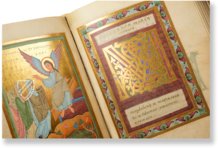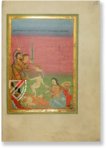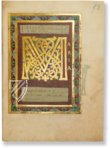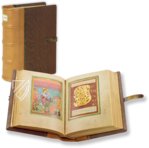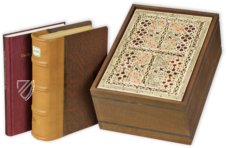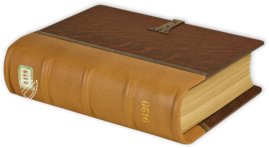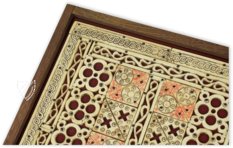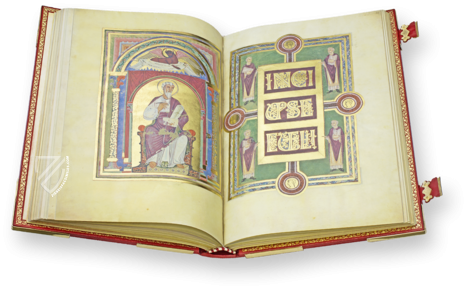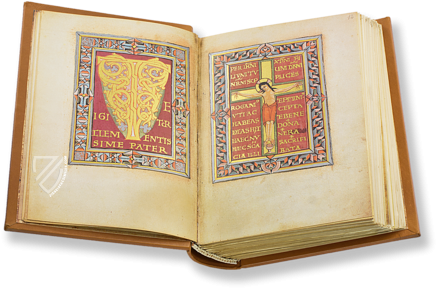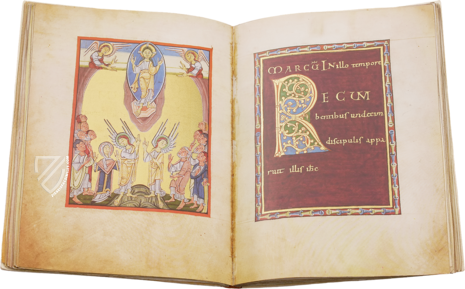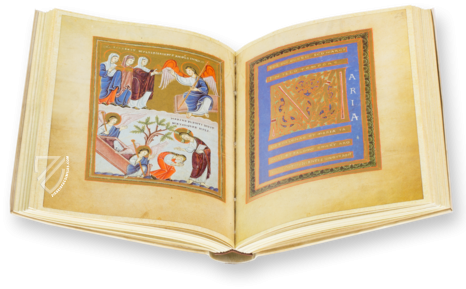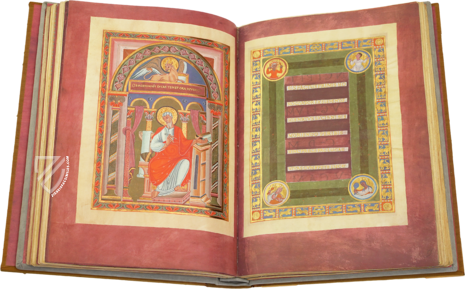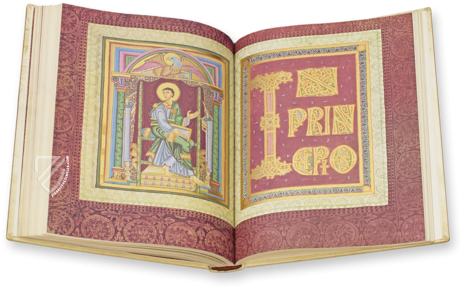Echternach Pericopes
(1,000€ - 3,000€)
The Echternach Pericopes originate from the famous scriptorium of the Salian Abbey of Echternach, which was already renowned for its great artistry in the Middle Ages. Located in present-day Luxembourg, the abbey produced one of the most magnificent and precious manuscripts ever created around 1030. The codex contains excerpts of liturgical texts from the four Gospels in the order of the church year, which were read on feast days. The relatively small-format 155 parchment folios of this splendid Ottonian masterpiece are not only largely written in gold ink, but above all present numerous impressive illuminations, most of which are full-page. The great innovative power of the scriptorium, which was inspired by late antique, Byzantine and Carolingian art, is evident in some of the pictorial themes, such as the Annunciation to the Shepherds and the picture cycle on the life of St. Stephen. The entire manuscript is luxuriously decorated with gold, purple and the most precious colors, giving it a unique glow.
The Echternach Pericopes
In the 11th century the Salian abbey of Echternach, whose history goes back to A.D. 690, possessed one of the most famous scriptoria in the medieval world and one of the most splendid libraries in all of the Occident. A gem originating from this writing workshop was the Echtenach Pericopes. The corpus is a collection of excerpts from the Pericopes that are ordered around the feast days of the church calendar and are intended for reading during mass. On 155 folios decorated in the most luxurious manner, the stories of the Bible are recorded in word and illustration.
The Salian Book Hoard
The Echternach Pericopes originated in 1030. At this time, the scriptorium of the Salian house monastery was in its most creative period. The corpus is not the result of a special commission, but rather the monks of the abbey kept the luxuriously decorated book as proof of their artistic ability and to assure their place in the highest tier of Occidental book art. Today this fine manuscript is to be found in the Royal Belgian Library in Brussels.
A Firework of Book Illumination
The monks of Echternach shied away from neither cost nor labor for the numerous decorations of the manuscript. The corpus begins with a true masterpiece of miniature painting. A full-paged depiction of the Maiestas Domini, the beloved image of Christ on his throne surrounded by four symbols of the pericopes, was painted in the charmingly simple color scheme of kingly purple and gold. Following this work of art are the portraits of the four evangelists and a few depictions of other saints, for which nonetheless no luxurious gold elements were spared. In total one finds 41 illustrations decorated with gold, 13 richly appointed pages of text, and more than 250 bold multiline initials in the codex.
Originals from Echternach
The Echternach Pericopes are especially interesting not only because of the impressively expensive materials that were chosen, but also for its thrilling new style of manuscript illumination. At first glance, the depictions appear to be rather simple, however upon further examination, the various influences that the Echternach monks combined with one another become apparent. Late Antique, Byzantine, and Carolingian examples served them, but they also found inspiration from contemporary painting techniques. The result was an unmistakable collection of stirring pictures of the life of Jesus Christ, scenes of which are depicted in a manner never before seen.
Inspiring New Stories in Pictures
A few details of the corpus are especially worthy of note, which one could say mark a revolution of monastic book making. The Annunciation to the Shepherds is a distinctive feature. The scene was not treated as a part of Christ’s birth, as had been previously done, but stood instead as its own extensive and cohesive miniature. Luminous colors were chosen, which interact brilliantly within golden framing. Furthermore, it features the first picture cycle concerning the story of St. Stephen, which depicts the excavation work done by the common people, i.e. the search and discovery of the martyr's bones. Astonishingly exact pictures show workers with hammers and shovels, vintners who were paid for their services with gold pieces, and further everyday scenes from medieval life that were previously never held to be worthy of depiction. The Echternach Pericopes, with this sprawling diversity of stories and richness of illustration, created something to inspire the beholder to this day.
Codicology
- Alternative Titles
- Echternacher Evangelistar
Echternach Gospel Lectionary - Size / Format
- 310 pages / 20.5 × 14.7 cm
- Origin
- Luxembourg
- Date
- Ca. 1030
- Epochs
- Style
- Language
- Script
- Carolingian minuscule Roman rustic capitals Roman uncial
- Illustrations
- 41 mostly full-page miniatures, 13 generously decorated text pages, 250+ lavishly ornate gold initials, and majuscule text written in gold ink
- Content
- Collection of excerpts from the Pericopes in the order of the church year
- Previous Owners
- Bremen Cathedral
Jesuit College of Cologne
Bibliothèque Nationale de France
Echternach Pericopes
Incipit Page: Mark 16
Large initials created with elaborate interlace and the generous employment of gold leaf were a common feature of Ottonian illuminated manuscripts. This fine “M” initial has been made all the more striking by the stark contrast with the purple background and introduces the discovery of Christ’s empty tomb by three of his disciples. “Now when the Sabbath was past, Mary Magdalene, Mary the mother of James, and Salome bought spices, that they might come and anoint Him.” (Mk. 16:1)
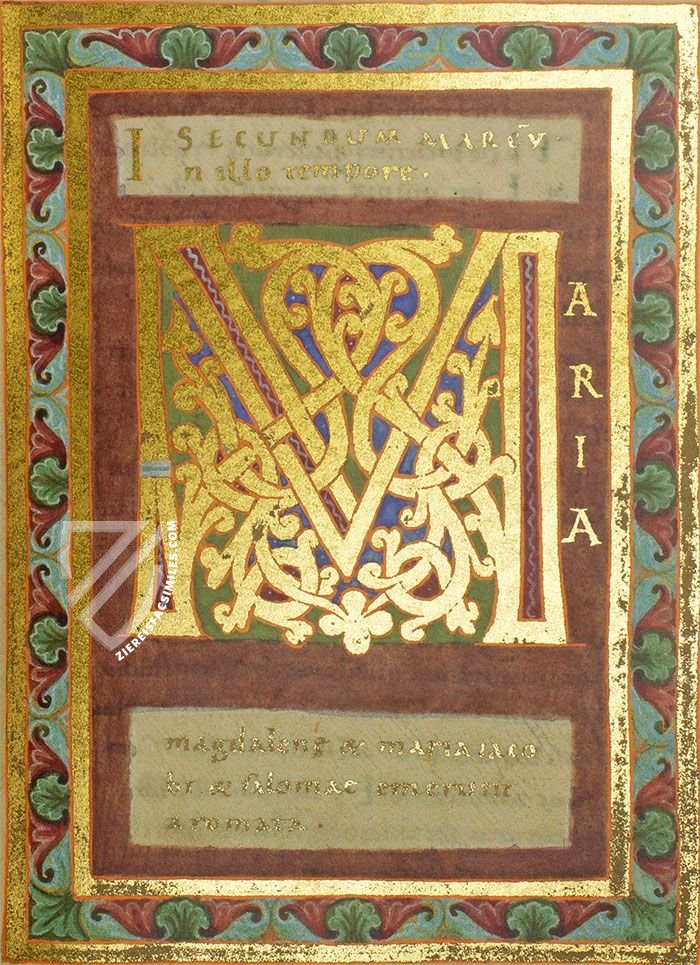
Echternach Pericopes
Christ in Majesty
The so-called Maiestas Domini is one of the most popular images in Western Christian art. Modelled on depictions of the Roman Emperor, Christ is always depicted enthroned, framed by a mandorla, and flanked by other holy figures, in this case the Evangelist symbols. This image serves as the frontispiece of one of Echternach’s greatest creations.
Painted in the royal colors of purple and gold, this is a true masterpiece. Although sitting, the burnished gold background makes Christ appear as though he is floating with the Alpha and Omega symbols barely visible above his shoulders. His piercing gaze looks through the beholder, not merely at them. The powerful image conveys a timeless, spaceless feel approximating the eternal nature of God.
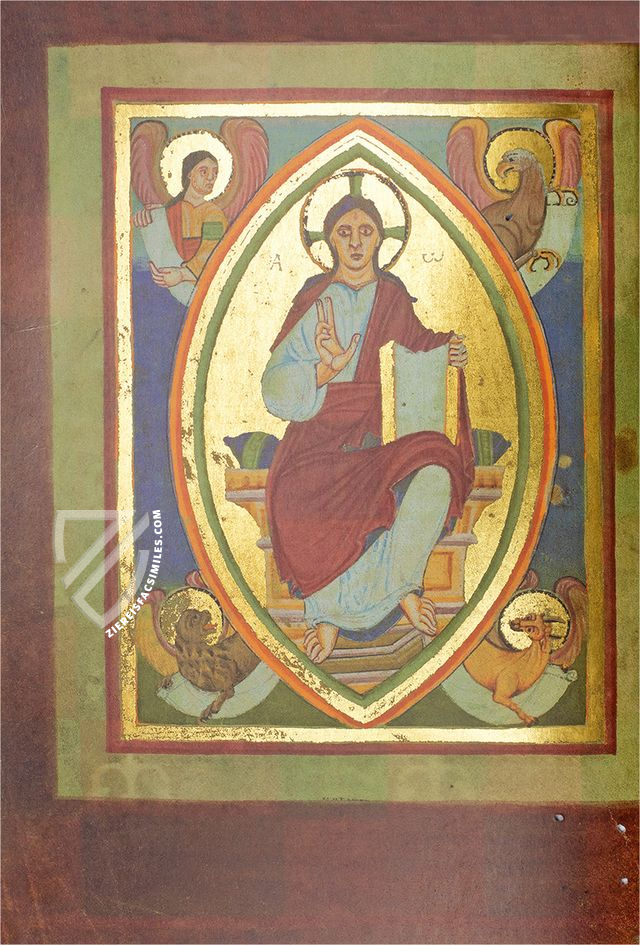
#1 Echternacher Evangelistar
Languages: French, German
(1,000€ - 3,000€)
- Treatises / Secular Books
- Apocalypses / Beatus
- Astronomy / Astrology
- Bestiaries
- Bibles / Gospels
- Chronicles / History / Law
- Geography / Maps
- Saints' Lives
- Islam / Oriental
- Judaism / Hebrew
- Single Leaf Collections
- Leonardo da Vinci
- Literature / Poetry
- Liturgical Manuscripts
- Medicine / Botany / Alchemy
- Music
- Mythology / Prophecies
- Psalters
- Other Religious Books
- Games / Hunting
- Private Devotion Books
- Other Genres
- Afghanistan
- Armenia
- Austria
- Belgium
- Belize
- Bosnia and Herzegovina
- China
- Colombia
- Costa Rica
- Croatia
- Cyprus
- Czech Republic
- Denmark
- Egypt
- El Salvador
- Ethiopia
- France
- Germany
- Greece
- Guatemala
- Honduras
- Hungary
- India
- Iran
- Iraq
- Israel
- Italy
- Japan
- Jordan
- Kazakhstan
- Kyrgyzstan
- Lebanon
- Liechtenstein
- Luxembourg
- Mexico
- Morocco
- Netherlands
- Palestine
- Panama
- Peru
- Poland
- Portugal
- Romania
- Russia
- Serbia
- Spain
- Sri Lanka
- Sweden
- Switzerland
- Syria
- Tajikistan
- Turkey
- Turkmenistan
- Ukraine
- United Kingdom
- United States
- Uzbekistan
- Vatican City
- A. Oosthoek, van Holkema & Warendorf
- Aboca Museum
- Ajuntament de Valencia
- Akademie Verlag
- Akademische Druck- u. Verlagsanstalt (ADEVA)
- Aldo Ausilio Editore - Bottega d’Erasmo
- Alecto Historical Editions
- Alkuin Verlag
- Almqvist & Wiksell
- Amilcare Pizzi
- Andreas & Andreas Verlagsbuchhandlung
- Archa 90
- Archiv Verlag
- Archivi Edizioni
- Arnold Verlag
- ARS
- Ars Magna
- ArtCodex
- AyN Ediciones
- Azimuth Editions
- Badenia Verlag
- Bärenreiter-Verlag
- Belser Verlag
- Belser Verlag / WK Wertkontor
- Benziger Verlag
- Bernardinum Wydawnictwo
- BiblioGemma
- Biblioteca Apostolica Vaticana (Vaticanstadt, Vaticanstadt)
- Bibliotheca Palatina Faksimile Verlag
- Bibliotheca Rara
- Boydell & Brewer
- Bramante Edizioni
- Bredius Genootschap
- Brepols Publishers
- British Library
- C. Weckesser
- Caixa Catalunya
- Canesi
- CAPSA, Ars Scriptoria
- Caratzas Brothers, Publishers
- Carus Verlag
- Casamassima Libri
- Centrum Cartographie Verlag GmbH
- Chavane Verlag
- Christian Brandstätter Verlag
- Circulo Cientifico
- Club Bibliófilo Versol
- Club du Livre
- CM Editores
- Collegium Graphicum
- Collezione Apocrifa Da Vinci
- Comissão Nacional para as Comemorações dos Descobrimentos Portugueses
- Coron Verlag
- Corvina
- CTHS
- D. S. Brewer
- Damon
- De Agostini/UTET
- De Nederlandsche Boekhandel
- De Schutter
- Deuschle & Stemmle
- Deutscher Verlag für Kunstwissenschaft
- DIAMM
- Droz
- E. Schreiber Graphische Kunstanstalten
- Ediciones Boreal
- Ediciones Grial
- Ediclube
- Edições Inapa
- Edilan
- Editalia
- Edition Deuschle
- Edition Georg Popp
- Edition Leipzig
- Edition Libri Illustri
- Editiones Reales Sitios S. L.
- Éditions de l'Oiseau Lyre
- Editions Medicina Rara
- Editorial Casariego
- Editorial Mintzoa
- Editrice Antenore
- Editrice Velar
- Edizioni Edison
- Egeria, S.L.
- Eikon Editores
- Electa
- Emery Walker Limited
- Enciclopèdia Catalana
- Eos-Verlag
- Ephesus Publishing
- Ernst Battenberg
- Eugrammia Press
- Extraordinary Editions
- Fackelverlag
- Facsimila Art & Edition
- Facsimile Editions Ltd.
- Facsimilia Art & Edition Ebert KG
- Faksimile Verlag
- Feuermann Verlag
- Folger Shakespeare Library
- Franco Cosimo Panini Editore
- Friedrich Wittig Verlag
- Fundación Hullera Vasco-Leonesa
- G. Braziller
- Gabriele Mazzotta Editore
- Gebr. Mann Verlag
- Gesellschaft für graphische Industrie
- Getty Research Institute
- Giovanni Domenico de Rossi
- Giunti Editore
- Graffiti
- Grafica European Center of Fine Arts
- Guido Pressler
- Guillermo Blazquez
- Gustav Kiepenheuer
- H. N. Abrams
- Harrassowitz
- Harvard University Press
- Helikon
- Hendrickson Publishers
- Henning Oppermann
- Herder Verlag
- Hes & De Graaf Publishers
- Hoepli
- Holbein-Verlag
- Houghton Library
- Hugo Schmidt Verlag
- Idion Verlag
- Il Bulino, edizioni d'arte
- ILte
- Imago
- Insel Verlag
- Insel-Verlag Anton Kippenberger
- Instituto de Estudios Altoaragoneses
- Instituto Nacional de Antropología e Historia
- Introligatornia Budnik Jerzy
- Istituto dell'Enciclopedia Italiana - Treccani
- Istituto Ellenico di Studi Bizantini e Postbizantini
- Istituto Geografico De Agostini
- Istituto Poligrafico e Zecca dello Stato
- Italarte Art Establishments
- Jan Thorbecke Verlag
- Johnson Reprint Corporation
- Josef Stocker
- Josef Stocker-Schmid
- Jugoslavija
- Karl W. Hiersemann
- Kasper Straube
- Kaydeda Ediciones
- Kindler Verlag / Coron Verlag
- Kodansha International Ltd.
- Konrad Kölbl Verlag
- Kurt Wolff Verlag
- La Liberia dello Stato
- La Linea Editrice
- La Meta Editore
- Lambert Schneider
- Landeskreditbank Baden-Württemberg
- Leo S. Olschki
- Les Incunables
- Liber Artis
- Library of Congress
- Libreria Musicale Italiana
- Lichtdruck
- Lito Immagine Editore
- Lumen Artis
- Lund Humphries
- M. Moleiro Editor
- Maison des Sciences de l'homme et de la société de Poitiers
- Manuscriptum
- Martinus Nijhoff
- Maruzen-Yushodo Co. Ltd.
- MASA
- Massada Publishers
- McGraw-Hill
- Metropolitan Museum of Art
- Militos
- Millennium Liber
- Müller & Schindler
- Nahar - Stavit
- Nahar and Steimatzky
- National Library of Wales
- Neri Pozza
- Nova Charta
- Oceanum Verlag
- Odeon
- Orbis Mediaevalis
- Orbis Pictus
- Österreichische Staatsdruckerei
- Oxford University Press
- Pageant Books
- Parzellers Buchverlag
- Patrimonio Ediciones
- Pattloch Verlag
- PIAF
- Pieper Verlag
- Plon-Nourrit et cie
- Poligrafiche Bolis
- Presses Universitaires de Strasbourg
- Prestel Verlag
- Princeton University Press
- Prisma Verlag
- Priuli & Verlucca, editori
- Pro Sport Verlag
- Propyläen Verlag
- Pytheas Books
- Quaternio Verlag Luzern
- Reales Sitios
- Recht-Verlag
- Reichert Verlag
- Reichsdruckerei
- Reprint Verlag
- Riehn & Reusch
- Roberto Vattori Editore
- Rosenkilde and Bagger
- Roxburghe Club
- Salerno Editrice
- Saltellus Press
- Sandoz
- Sarajevo Svjetlost
- Schöck ArtPrint Kft.
- Schulsinger Brothers
- Scolar Press
- Scrinium
- Scripta Maneant
- Scriptorium
- Shazar
- Siloé, arte y bibliofilia
- SISMEL - Edizioni del Galluzzo
- Sociedad Mexicana de Antropología
- Société des Bibliophiles & Iconophiles de Belgique
- Soncin Publishing
- Sorli Ediciones
- Stainer and Bell
- Studer
- Styria Verlag
- Sumptibus Pragopress
- Szegedi Tudomànyegyetem
- Taberna Libraria
- Tarshish Books
- Taschen
- Tempus Libri
- Testimonio Compañía Editorial
- Thames and Hudson
- The Clear Vue Publishing Partnership Limited
- The Facsimile Codex
- The Folio Society
- The Marquess of Normanby
- The Richard III and Yorkist History Trust
- Tip.Le.Co
- TouchArt
- TREC Publishing House
- TRI Publishing Co.
- Trident Editore
- Tuliba Collection
- Typis Regiae Officinae Polygraphicae
- Union Verlag Berlin
- Universidad de Granada
- University of California Press
- University of Chicago Press
- Urs Graf
- Vallecchi
- Van Wijnen
- VCH, Acta Humaniora
- VDI Verlag
- VEB Deutscher Verlag für Musik
- Verlag Anton Pustet / Andreas Verlag
- Verlag Bibliophile Drucke Josef Stocker
- Verlag der Münchner Drucke
- Verlag für Regionalgeschichte
- Verlag Styria
- Vicent Garcia Editores
- W. Turnowski Ltd.
- W. Turnowsky
- Waanders Printers
- Wiener Mechitharisten-Congregation (Wien, Österreich)
- Wissenschaftliche Buchgesellschaft
- Wissenschaftliche Verlagsgesellschaft
- Wydawnictwo Dolnoslaskie
- Xuntanza Editorial
- Zakład Narodowy
- Zollikofer AG

